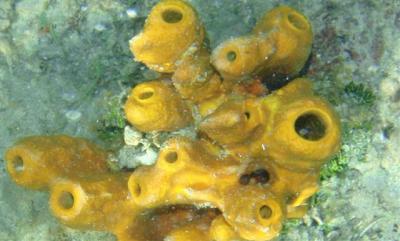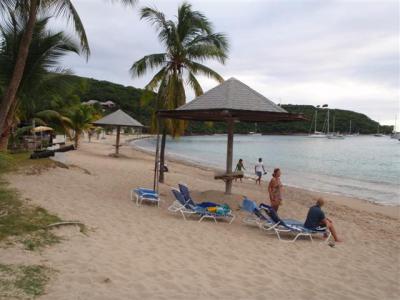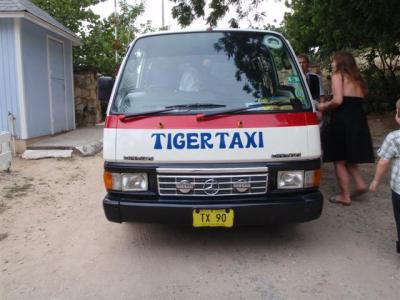Christi started the morning by scrubbing the waterline. The starboard side had little growth, but the port side had a lot of growth. The growth was fairly thin at the bow and got progressively thicker the farther back on the boat. The port aft quarter of the waterline looks like a carpet. And it didn’t want to come off. She got all the growth off the starboard side and the front half of the port side and had tackled most of the aft half before she decided to take a break. She was tired and the current was picking up. She planned to finish the water line and tackle the metal at 1600, during slack tide.
After Christi had rested for an hour, we decided to go snorkeling. There are some rocks in the southeast corner of the harbor that are supposedly a good snorkeling spot. And since we are anchored so close, it is a short swim from Kosmos.
The ground underneath the anchorage area is mostly that Posidonia grass intermixed in with another thinner, greener type of grass. Near the rocks, the grass vanishes. The rocks have no substantial growth, just small patches of coral and sponges all around. It almost looks like a vibrant reef was completely washed away in a storm and is trying to grow back, except that there is no telltale dead coral around to support our theory. What is interesting is that while the growth patches are tiny, there are lots of different kinds of species. The first photo is of yellow tube sponge. In Deshaies, they were 4 feet tall and came in both yellow and purple. The second photo is also of sponges. We are not sure what this kind is called, nor whether the two different colors are different species.


In addition to those, we also saw one lavender fan coral, some brain coral, some great star coral, some pillar coral, and lots more. Like the dive spot we went to in Guadeloupe, there weren’t very many fish in the water, but there were certainly a big variety. And like Guadeloupe, the fish here are small, but noticeably bigger than what we saw in Guadeloupe. The biggest fish we saw was a flounder hiding in the sand on the ground. We saw several vibrant little damselfish, one variety was yellow and purple and another variety was bright blue and yellow. We also saw several little striped wrasse, which our fish book says are juvenile parrotfish. Wow, they change dramatically from juvenile to adults! We saw a few small parrotfish with colors that were more pastel than bright, angel fish, goatfish, gruntfish, some little red rabbitfish or squirrelfish (we have a hard time telling them apart), and a couple varieties of butterfly fish. The one pictured below is called a four eyed butterfly fish, and there was also a black and white striped one called a banded butterfly fish. The second photo is of Kosmos and English Harbor, taken from the east side of the bay and facing west.


While we were snorkeling, Arielle arrived and dropped anchor in front of Kosmos. We swam over to say hi. One of the guys, Michael, asked if we had gone to shore yet to check in and pay the anchorage fee. Of course, we hadn’t. Michael was on his way to shore to do that, so he offered to take Eric along. Eric quickly cleaned up and the two set off.
In the History of Antigua & Barbuda, we mentioned that in the 1700’s the British Navy built a dockyard in English Harbor, and shortly thereafter this harbor became the main base for the English Caribbean Naval Fleet. The British military abandoned this base in 1889, and by 1947, the dockyard was in total ruins. A gentleman named Vernon Nicholson opened a charter business in English harbor, and spearheaded a campaign to restore the historic ruins to their former glory. During the restoration the base was re-named from “Antigua Navy Yard” to “Nelson’s Dockyard”, after Horatio Nelson, England’s favorite hero. Nelson was stationed here from 1784 to 1787. Thanks to Nicholson, Nelson’s Dockyard became a functional historic monument managed by the National Parks Authority and a major Caribbean yachting center. It is the only working Georgian Dockyard in the world. Being that English Harbor is part of the national park along with Nelson’s dockyard, there is a small daily fee to anchor here. From what Eric could tell, the dockyard is a cluster of pretty, historic old buildings on a small peninsula that sticks out into the middle of the harbor. The old buildings are occupied with assorted modern businesses, including the marina office where he paid the fees.
While on shore, the men found out that the “happening” thing to do on Sunday nights is go to a restaurant located in Shirley Heights to see a band play. Shirley Heights is another historic British Naval Base that was in use at the same time as Nelson’s Dockyard. It is located at the top of the hill and it is supposed to have great views. Michael offered to ferry us to shore and share a taxi up the hill. The shin dig started around 1700, so that meant abandoning part 2 of bottom cleaning for today. Christi was more than happy to see a band play versus scrub the bottom.
We headed over to a dinghy dock on the sandy shore due north of Kosmos. There were several other people waiting for cabs there, too. We got in line. The photo is of the east side of the bay. We were snorkeling at the back right hand corner, and that is where we took the photo above facing west.

The first taxi to pull up was a Nissan-Mercedes-Nissan mini-bus. The second was a Lexus-Toyota mini-bus. We are most amused by the car brands here.

We were at the bar shortly after 1700. The cover charge was $8 USD. There was a steel drum band playing pleasant calypso background music, no vocals. Everyone gathered on the cliff clearly marked “Do not go here” and watched the sunset over beautiful English and Falmouth Harbors. English harbor is in the foreground and Falmouth Harbor is in the background. The bit of water to the right and in the middle is also English Harbor, though in this photo it looks like English Harbor ends at the spit of land Nelson’s Dockyard is on.

There were food and drinks available for purchase. It was a BBQ menu. The food was nothing special, and we thought it was a little expensive given the portion size. At 2000, the band came on. They were really good. We recognized almost all the songs as covers. Some were reggae tunes, many more were pop tunes that were calysoized, making them a little more fun and festive than the regular version. The restaurant was packed and the dance floor was shoulder to shoulder. We left around 1030 and the band hadn’t taken a single break. We’ve never seen a band play so long before. All in all, it was a good time.

I don’t know Eric, you’ve become too liberal during your voyage. I would have left my wife on the boat to scrub the bottom while I was at a concert with the boys. But that’s just me!^)
-rich
welistened to a band up on the top